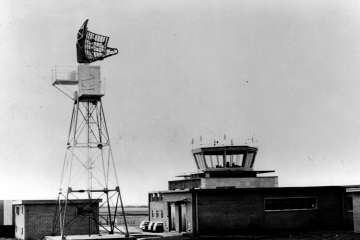AR-1
Description of the radar set, tactical-technical characteristics

Figure 1: AR-1
| Specifications | |
|---|---|
| frequency: | 2 750 … 3 050 MHz
( S-Band) |
| pulse repetition time (PRT): | |
| pulse repetition frequency (PRF): | 700 Hz |
| pulsewidth (τ): | 1 µs |
| receive time: | |
| dead time: | |
| peak power: | 2 × 650 kW |
| average power: | 2 × 455 W |
| instrumented range: | 70 NM (≙ 130 km) |
| range resolution: | |
| accuracy: | |
| beamwidth: | |
| hits per scan: | |
| antenna rotation: | 15 rpm |
| MTBCF: | |
| MTTR: | |
AR-1
The DECCA (later: Plessey) AR-1 is an 2-D terminal approach radar operating in the S-Band. The AR-1 was designed to meet both military and civil airfield approach control requirements.
AR-1 is a frequency diversity radar using two magnetron fitted transmitters and two receivers using a klystron as stable local oscillator, an a low-noise traveling wave tube (TWT) as RF-pre-amplifier. The AR-1 used an analog system for Moving Target Indication (MTI). It used many different display configurations, utilising the new Fixed Coil PPI-Display.
The antenna of the AR-1 was linearly horizontal polarised only. The innovative shape of the double curved reflector with cosecant-squared pattern was exemplary for many later radars, right up to the Watchman.
The AR-1 was installed on a number of international airports, e.g. in 1966 in Sofia, Bulgaria.
